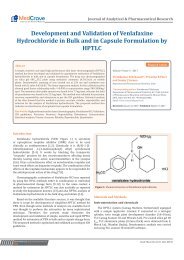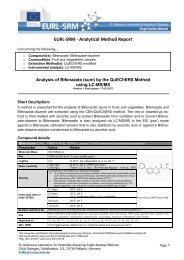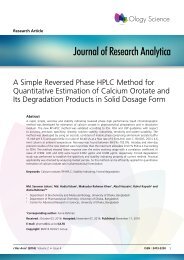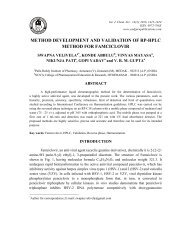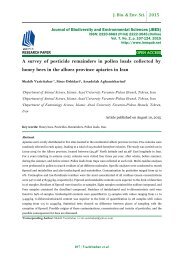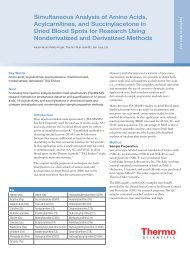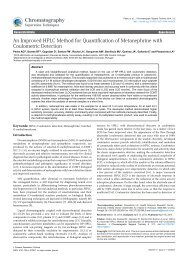382 SHENG LI et al.Arabia and Jordan have already introduced clinicalplacements which are not only related to pharmacybut also to medical rotations (9, 18, 19). Academicpharmacists know about the PPA as one of the representingbody of pharmacists in Pakistan.Unfortunately, only half of the respondents hold itsmembership. They believed that PPA is working forthe interest of the pharmacists in the country.One of the major limitations of the study is thewinter vacation in the two provinces of the countryduring the time of data collection. Most of the academicpharmacists cannot be reached as they left forhigher education abroad. Time and financial constraintsare another contributing factors for lowresponse rate.CONCLUSIONThe pharmacists play a critical role in improvingthe healthcare in the society, which can only beachieved by providing the adequate learning opportunitiesfor the students, and which will be the futureof practicing pharmacists. Based on the findings ofthe survey, there is a lack of practical exposure forthe pharmacy students. There is a strong and uniformdesire in both the public and private academiathat the major emphasis should be placed on theimprovement and amendments in terms of pharmacycurriculum. For the uplifting of pharmacy professionin Pakistan, support of government and pharmacyorganization is very essential. Then, the pharmacypractice will be as advanced as it is in otherparts of the world.AcknowledgmentThe authors thank the Beijing Haidian Hospitalsince this study was accomplished through the cooperationbetween Beijing Haidian Hospital andCOMSATS Institute of Information Technology.REFERENCES1. Azhar S., Hassali M.A., Ibrahim M.I.: Trop. J.Pharm. Res. 9, 205 (2010).2. WHO: New tool to enhance role of pharmacistsin health care, 2006.3. Carter O., Nathisuwan S., Stoddard G., MungerM.A.: Ann. Pharmacother. 37, 197 (2003).4. Aysegul Y.: Int. J. Nurs. Stud. 42, 429 (2005).5. Anderson C.: Human Res. Health, 7, 45 (2009).6. Amie D.B.: Curr. Pharm. Teach. Learn. 1, 2(2009).7. Patry R.A., Eiland L.S.: Am. J. Health SystemPharm. 64, 773 (2007).8. Raehl C.L.: Pharmacotherapy 22, 445 (2002).9. Al-Wazaify M.: Am. J. Pharm. Educ. 70, 18(2006).10. Taylor K.M.G., Bates I.P., Harding G.: Pharm.Educ. 4, 33 (2004).11. Murtaza G., Rehman N.U., Khan S.A., Noor T.,Bashir D. et al.: Latin Am. J. Pharm. 31, 958(2012).12. Ahsan N.: Pakistan Drug Update 6, p. 7 (2005).13. Salameh P., Hamdan I.: Res. Social Admin.Pharm. 3, 336 (2007).14. Jamshed S., Babar Z.U., Ibrahim M.I.M.: Am.J. Pharm. Educ. 73, 1 (2009).15. Babar Z.U.D.: Am. J. Pharm. Educ. 69, 5(2005).16. Azhar S.: Human Res. Health 7, 54 (2009).17. Kheir N.: Am. J. Pharm. Educ. 72, 133 (2009).18. Awad A., Matowe L., Capps P.: Pharm. WorldSci. 29, 557 (2007).19. Chen L., Zhou Y., Zeng J., Yang P., Guo Y. etal.: J. Craniofac. Surg., 5, 1731 (2013).Received: 7. 01. 2014
Acta Poloniae Pharmaceutica ñ Drug Research, Vol. 72 No. 2 pp. 383ñ387, <strong>2015</strong> ISSN 0001-6837Polish Pharmaceutical SocietyMICROBIOLOGICAL QUALITY OF FOOD SUPPLEMENTSMAGDALENA RATAJCZAK*, MARCELINA M. KUBICKA, DOROTA KAMI—SKAand JOLANTA D£UGASZEWSKADepartment of Genetics and Pharmacutical Microbiology, PoznaÒ University of Medical Sciences,åwiÍcickiego 4, 60-781 PoznaÒ, PolandAbstract: Many specialists note that the food offered today ñ as a result of very complex technological processingñ is devoid of many components that are important for the organism and the shortages have to be supplemented.The simplest for it is to consume diet supplements that provide the missing element in a concentratedform. In accordance with the applicable law, medicinal products include all substances or mixtures ofsubstances that are attributed with properties of preventing or treating diseases with humans or animals. Permitsto admit supplements to the market are issued by the Chief Sanitary Inspector and the related authorities; permitsfor medicines are issued by the Chief Pharmaceutical Inspector and the Office for Registration ofMedicinal Products, Medical Devices and Biocidal Products. Therefore, admittance of a supplement to the marketis less costly and time consuming than admittance of a medicine. Supplements and medicines may containthe same component but medicines will have a larger concentration than supplements. Sale of supplements atdrug stores and in the form of tablets, capsules, liquids or powders makes consumer often confusing supplementswith medicines. Now there are no normative documents specifying limits of microbiological impuritiesin diet supplements. In Polish legislation, diet supplements are subject to legal acts concerning food. Medicineshave to comply with microbiological purity requirements specified in the Polish Pharmacopeia. As evidencedwith the completed tests, the proportion of diet supplement samples with microbiological impurities is 6.5%.Sales of diet supplements have been growing each year, they are consumed by healthy people but also peoplewith immunology deficiencies and by children and therefore consumers must be certain that they buy safe products.Keywords: microbiological purity, Good Manufacturing Practice (GMP), diet supplementsAccording to the definition included in the Actof 25 August 2006 on the Safety of Food andNutrition, dietary supplements are ìfoodstuffsintended to add further nutritional value to the normaldiet, representing concentrated sources of vitamins,minerals or other substances having a nutritionalor otherwise physiological effect, either individualor combined, marketed in a dosage formî (1).There are currently no normative documentsspecifying microbiological contamination limits fordietary supplements. In the Polish legislation,dietary supplements are subject to legal acts regulatingfood products. Pursuant to the Act on the Safetyof Food and Nutrition, all business entities operatingon the food market are obliged to comply withrequirements of Good Hygiene Practice (GHP) intheir production plants, and follow rules embodiedin the Hazard Analysis and Critical Control Points(HACCP) system.The aim of this work was to retrospectivelyanalyze results of studies investigating microbiologicalpurity of dietary supplements produced in pharmaceuticalmanufacturing plants in the Wielkopolskaregion.MATERIALS AND METHODSThe analysis comprised results of microbiologicalpurity tests performed for a total of 1165 samplesof the dietary supplements in form of tablets.Tablets were the final forms of dietary supplementsin the sales package, from three manufacturingplants. The study was performed within one monthfrom the date of manufacture of the product. Thestudies were conducted over a period of three years(from 2010 to 2012). Testing performed accordingto requirements set out by the ordering partyinvolved determination of total aerobic count, totalfungal count, presence and count of Gram-negativeEnterobacteriaceae bacteria, presence of Pseudomonasaeruginosa, Escherichia coli and Staphylococcusaureus in 1 g/mL, and Salmonella in 10* Corresponding author: e-mail: ratajczak.magdalena@wp.pl; phone/fax: 48-61-8546720383



